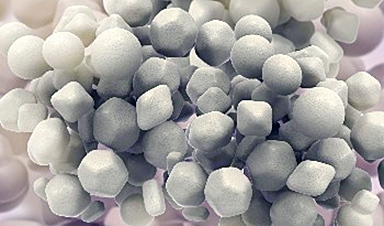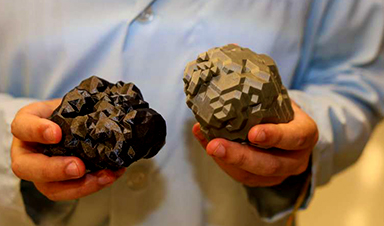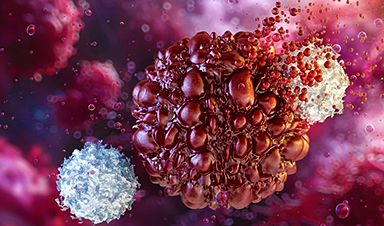In new research published in Nature Communications, University of Sussex scientists demonstrate how a highly conductive paint coating that they have developed mimics the network spread of a virus through a process called ‘explosive percolation’ – a mathematical process which can also be applied to population growth, financial systems and computer networks, but which has not been seen before in materials systems. The finding was a serendipitous development as well as a scientific first for the researchers.
The process of percolation – the statistical connectivity in a system, such as when water flows through soil or through coffee grounds – is an important component in the development of liquid technology. And it was that process which researchers in the University of Sussex Material Physics group were expecting to see when they added graphene oxide to polymer latex spheres, such as those used in emulsion paint, to make a polymer composite.
But when they gently heated the graphene oxide to make it electrically conductive, the scientists kick-started a process that saw this conductive system grow exponentially, to the extent that the new material created consumed the network, similar to the way a new strain of a virus can become dominant. This emergent material behaviour led to a new highly-conductive paint solution that, because graphene oxide is a cheap and easy to mass produce nanomaterial, is both one of the most affordable and most conductive low-loading composites reported. Before, now, it was accepted that such paints or coatings were necessarily one or the other.
Electrically conductive paints and inks have a range of useful applications in new printed technologies, for example by imparting coatings with properties such as anti-static or making coatings that block electromagnetic interference (EMI), as well as being vital in the development of wearable health monitors.
Alan Dalton, Professor of Experimental Physics, who heads up the Materials Physics Group at the University of Sussex explains the potential of this serendipitous finding: “My research team and I have been working on developing conductive paints and inks for the last ten years and it was to both my surprise and delight that we have discovered the key to revolutionising this work is a mathematical process that we normally associate with population growth and virus transmission.
“By enabling us to create highly-conductive polymer composites that are also affordable, thanks to the cheap and scalable nature of graphene oxide, this development opens up the doors to a range of applications that we’ve not even been able to fully consider yet, but which could greatly enhance the sustainability of Electric Vehicle materials – including batteries – as well as having the potential to add conductive coatings to materials, such as ceramics, that aren’t inherently so. We can’t wait to get going on exploring the possibilities.”
“The growth of this network is analogous to the emergence of high-transmission viral variants and could allow us to use epidemic modelling to develop exciting new materials or even materials to understand epidemic transmission.”
About the Experiment:
The scientists took polymer latex spheres and added graphene oxide. Through drying this solution, as you would dry paint, the graphene oxide becomes trapped between the spheres and as more graphene is added, the sheets eventually form a ‘percolating’ network within the latex film.
However, because graphene oxide isn’t electrically conductive, the scientists performed some mild heating to eliminate chemical defects (150C, similar to the temperature of a heat gun used to dry paint). When they did this, they found that the films not only become conductive – as expected – but became more conductive than if they were made entirely from the graphene.
The reason for this is that the sheets are trapped together between the latex spheres (rather than randomly arranged), the mild heating kick-starts chemical modification of the graphene which in turn chemically modifies the polymer to produce small molecules which crosslink (form chemical bridges between) the sheets which dramatically increases their conductivity. This phenomenon where, only at the point of percolation, the materials go through a ‘phase transition’ to form a completely different network than if they weren’t connected is known as ‘explosive percolation’. It can be thought of reaching a critical level of connectivity where the new material grows explosively through the network.
News
It’s Not “All in Your Head”: Scientists Develop Revolutionary Blood Test for Chronic Fatigue Syndrome
A 96% accurate blood test for ME/CFS could transform diagnosis and pave the way for future long COVID detection. Researchers from the University of East Anglia and Oxford Biodynamics have created a highly accurate [...]
How Far Can the Body Go? Scientists Find the Ultimate Limit of Human Endurance
Even the most elite endurance athletes can’t outrun biology. A new study finds that humans hit a metabolic ceiling at about 2.5 times their resting energy burn. When ultra-runners take on races that last [...]
World’s Rivers “Overdosing” on Human Antibiotics, Study Finds
Researchers estimate that approximately 8,500 tons of antibiotics enter river systems each year after passing through the human body and wastewater treatment processes. Rivers spanning millions of kilometers across the globe are contaminated with [...]
Yale Scientists Solve a Century-Old Brain Wave Mystery
Yale scientists traced gamma brain waves to thalamus-cortex interactions. The discovery could reveal how brain rhythms shape perception and disease. For more than a century, scientists have observed rhythmic waves of synchronized neuronal activity [...]
Can introducing peanuts early prevent allergies? Real-world data confirms it helps
New evidence from a large U.S. primary care network shows that early peanut introduction, endorsed in 2015 and 2017 guidelines, was followed by a marked decline in clinician-diagnosed peanut and overall food allergies among [...]
Nanoparticle blueprints reveal path to smarter medicines
Lipid nanoparticles (LNPs) are the delivery vehicles of modern medicine, carrying cancer drugs, gene therapies and vaccines into cells. Until recently, many scientists assumed that all LNPs followed more or less the same blueprint, [...]
How nanomedicine and AI are teaming up to tackle neurodegenerative diseases
When I first realized the scale of the challenge posed by neurodegenerative diseases, such as Alzheimer's, Parkinson's disease and amyotrophic lateral sclerosis (ALS), I felt simultaneously humbled and motivated. These disorders are not caused [...]
Self-Organizing Light Could Transform Computing and Communications
USC engineers have demonstrated a new kind of optical device that lets light organize its own route using the principles of thermodynamics. Instead of relying on switches or digital control, the light finds its own [...]
Groundbreaking New Way of Measuring Blood Pressure Could Save Thousands of Lives
A new method that improves the accuracy of interpreting blood pressure measurements taken at the ankle could be vital for individuals who are unable to have their blood pressure measured on the arm. A newly developed [...]
Scientist tackles key roadblock for AI in drug discovery
The drug development pipeline is a costly and lengthy process. Identifying high-quality "hit" compounds—those with high potency, selectivity, and favorable metabolic properties—at the earliest stages is important for reducing cost and accelerating the path [...]
Nanoplastics with environmental coatings can sneak past the skin’s defenses
Plastic is ubiquitous in the modern world, and it's notorious for taking a long time to completely break down in the environment - if it ever does. But even without breaking down completely, plastic [...]
Chernobyl scientists discover black fungus feeding on deadly radiation
It looks pretty sinister, but it might actually be incredibly helpful When reactor number four in Chernobyl exploded, it triggered the worst nuclear disaster in history, one which the surrounding area still has not [...]
Long COVID Is Taking A Silent Toll On Mental Health, Here’s What Experts Say
Months after recovering from COVID-19, many people continue to feel unwell. They speak of exhaustion that doesn’t fade, difficulty breathing, or an unsettling mental haze. What’s becoming increasingly clear is that recovery from the [...]
Study Delivers Cancer Drugs Directly to the Tumor Nucleus
A new peptide-based nanotube treatment sneaks chemo into drug-resistant cancer cells, providing a unique workaround to one of oncology’s toughest hurdles. CiQUS researchers have developed a novel molecular strategy that allows a chemotherapy drug to [...]
Scientists Begin $14.2 Million Project To Decode the Body’s “Hidden Sixth Sense”
An NIH-supported initiative seeks to unravel how the nervous system tracks and regulates the body’s internal organs. How does your brain recognize when it’s time to take a breath, when your blood pressure has [...]
Scientists Discover a New Form of Ice That Shouldn’t Exist
Researchers at the European XFEL and DESY are investigating unusual forms of ice that can exist at room temperature when subjected to extreme pressure. Ice comes in many forms, even when made of nothing but water [...]





















